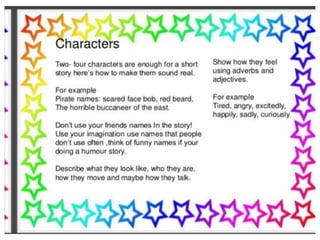PRACTING WRITING
- 1. READING AND REFLECTION ON TEXT Submitted by R.Abirami 19 USDV001
- 2. Practicing Writing- Picture description/Expansion of ideas/Essays/Stories.
- 3. INTRODUCTION: Writing, form of human communication by means of a set of visible marks that are related, by convention, to some particular structural level of language. Writing is a medium of human communication that involves the representation of a language with symbols. Writing systems are not themselves human languages; they are means of rendering a language into a form that can be reconstructed by other humans separated by time and/or space.
- 4. PICTURE DESCRIPTION: A picture description is an ideal way of practising your English vocabulary in all sorts of fields. PREPARATION: Have a close look at the picture and decide on how to structure your picture description. What is important or special? What should the viewer pay attention to?
- 5. Structure and Content: It's not easy to follow a picture description if the writer jumps randomly from one point to another. Therefore, make sure that your picture description is logically structured, for example: from left to right (or from right to left) from the background to the foreground (or from the foreground to the background) from the middle to the sides (or from the sides to the middle) from details to general impressions (or from general impressions to details)
- 6. Pictures in General: short description of the scene (e. g. place, event) details (who / what can you see) background information (if necessary) on place, important persons or event Paintings name of artist and picture, year of origin (if known) short description of the scene (e. g. place, event) details (who / what can you see) impression on the viewer artist's intention perspective, colours, forms, proportions etc.
- 9. Step 1: Understand the symbol of the words in the proverb: Most proverbs or ideas are symbolic. The name of place or animal or thing or person stands as a symbol of some quality. We have to try to understand that in the context of the proverb. For example take the proverb, ‘Rome was not built in a day‘. Here the noun ‘Rome’ is the name of a place. We also (should) know that Rome was a great city. So what does Rome stand for? It stands for Greatness or success. (Remember it was a great city).
- 10. Or take the example of ‘All that glitters is not gold‘. Here we have the noun ‘gold’. It is the name of a thing. We know that gold is a precious metal. So what does gold stand for? It stands for precious.
- 11. Step 2: Substitute the meaning in the idea or the proverb: Take the two previous examples. ‘Rome was not built in a day’ and ‘All that glitters is not gold’. Now substitute the symbols we found out earlier in the sentences. What do we have? ‘Greatness or success was not built in a day’ ‘All that glitters is not precious’ The proverb is now decoded and ready for understanding.
- 12. Step 3: Look for a story or anecdote or example or illustration: Now that you have understood what the proverb stands for or what the proverb means, we should look for a suitable example to illustrate it. Where do we get these stories? There are plenty of them. Aesop’s fables are ideal. So are the tales of India, the Panchatantra.
- 13. Step 4: Look for similar proverbs or ideas: “Patience, persistence and perspiration make an unbeatable combination for success” by Napoleon Hill is similar to ‘Rome was not built in a day’; so is the proverb ‘Do not judge the book by its cover’ similar to ‘All that glitters is not precious’.
- 14. Step 5: Sum up the paragraph: Use summing up words or phrases to indicate that you have finished the expansion and intend to sum it up. You could use ‘Thus’ or ‘In fine’ or ‘So’ or ‘The proverb advises that’. Let the reader know that you are signing off.
- 18. STORY
- 24. CONCLUSION: Writing equips us with communication and thinking skills. Writing expresses who we are as people. Writing makes our thinking and learning visible and permanent.
- 25. THANK YOU
























